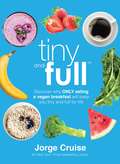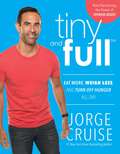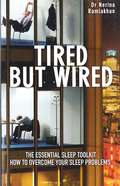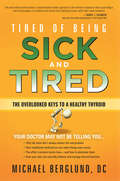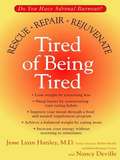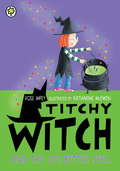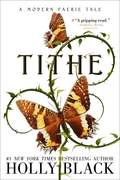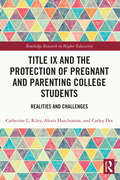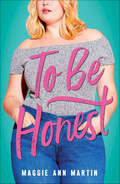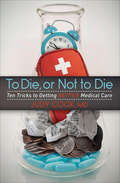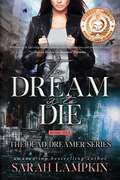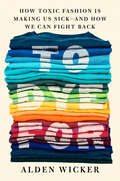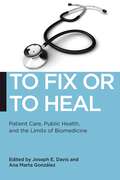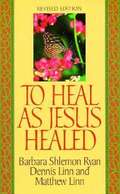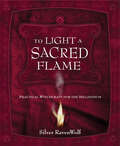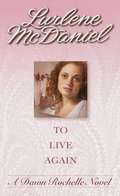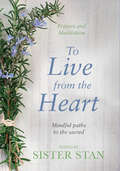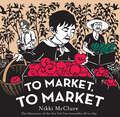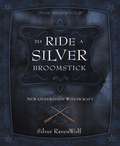- Table View
- List View
Tiny and Full: Discover Why Only Eating a Vegan Breakfast Will Keep You Tiny and Full for Life
by Jorge CruiseTotal health, natural weight loss, increased all-day energy . . . your breakfast holds the power!The vegan diet is more popular than ever, and people all over the world are touting its healthful benefits-longevity, energy, and even weight loss. For most of us, though, it's a lifestyle change just too hard to maintain. More important, it can be deficient in crucial nutrients for optimal wellness, such as vitamins A, D, K2, and B12.With Tiny and FullTM, you only have to wake up veganTM to see the results of a plant-based diet. You'll discover that eating vegan at just one meal-breakfast-is better for you than if you ate vegan all day long.By including yummy foods with animal protein, such as Greek yogurt, white fish, chicken, and so much more, in your lunch and dinner, you will get a complete, balanced diet that leaves you satisfied on the least amount of calories necessary and gives you a tiny waist in only 12 weeks!Tiny and FullTM gives you a straightforward meal plan and an energetic fitness program, plus 50 fun and delicious recipes-from a Tropical Mango Blast and Berry Blaster Bowl to Gorgonzola Pear Pizza and even Chocolate Avocado Mousse Cupcakes.This book provides all the guidelines you need to transform your body and improve your life-starting now!
Tiny and Full: Eat More, Weigh Less, and Turn Off Hunger All Day
by Jorge CruiseEat Off The Pounds! Imagine letting your body do the work for you. You no longer need to cut down your portions or spend countless hours in the gym to lose weight. Because Tiny and Full is not a diet—it's a revolutionary lifestyle, where you will discover how to eat MORE and still lose weight. Scientists and researchers have discovered "tiny calorie foods," or foods low in calorie but big in size, that can help you stay TINY but FULL. These foods allow you to turn off hunger by filling up and staying satisfied while cutting calories. Paired with more than 80 delicious recipes—everything from pizza to ice cream, a 12-week easy-to-follow meal planner, shopping lists, and at-home workouts too—you have all the tools you need to reach your weight-loss goals. NOW HARNESSING THE POWER OF THYROID BOOST This special edition of Tiny and Full now includes a brand-new, gluten-free Thyroid Boost meal planner designed to heal and boost your thyroid to its highest potential. The Thyroid Boost meal planner and recipes will help you overcome chronic fatigue, weight-loss plateaus, constipation, weight gain, and other thyroid issues and symptoms. Jorge Cruise is a leading fitness and nutrition expert and the #1 bestselling author of more than 20 books in 16 languages. His passion for health and fitness is shown on his Facebook Live show, Tiny Talks, with over 2 million viewers as well as the E! television series Revenge Body with Khloe Kardashian where he trains and transforms Khloe's favorite underdogs.
Tired But Wired: How to Overcome Sleep Problems
by Nerina RamlakhanExploring the underlying causes of common sleep problems, this guide offers solutions for how they can be easily overcome, revealing the potential for reclaiming a healthy balance in life. Acknowledging the breakneck speed of daily existence and how most people retire for the evening so exhausted they are unable to fall asleep, this handbook discusses the author's "Sleep Toolkit," a set of tried-and-true methods that has been developed with thousands of former patients, from burnt-out executives to mothers struggling with the demands of children and a full-time job. Overturning the myth that the average person requires eight hours of sleep every night, this examination argues that fewer hours of quality, restorative sleep are more valuable, presenting practical and accessible steps towards gaining an inner equilibrium that is physically and emotionally revitalizing. Unveiling the key to discovering natural rhythms, this reference is guaranteed to fit any lifestyle or personality, providing all the essential habits and routines necessary for optimal sleep.
Tired Teens: Understanding and Conquering Chronic Fatigue and POTS
by Philip R. FischerA Mayo Clinic pediatrician&’s guide to the causes of fatigue in teenagers—and finding the care they may need. What happens when a perfectly healthy teen suddenly becomes tired and lethargic? In Tired Teens, Dr. Philip R. Fischer draws upon decades of experience as a pediatrician to pinpoint causes of chronic fatigue in teens and explains how teens and parents can help combat these debilitating conditions. Preparing for college applications, keeping up with schoolwork, and balancing a variety of extracurricular activities, all while maintaining a social life, is causing modern-day teens to become overworked and under-rested. While some students manage to keep up with this packed schedule, many teens go from being A+ students to barely being able to get out of bed in the morning. Some causes of excessive tiredness, like lack of sleep and improper sleep hygiene, can be easy to remedy. However, other causes, like digestive problems, hormonal changes, and postural orthostatic tachycardia syndrome (POTS), may require more serious care. In Tired Teens, Dr. Fischer explains how to identify the warning signs and symptoms of chronic fatigue in teens, helping you determine if your teen&’s excessive tiredness is simply a symptom of a busy schedule, or the result of an unexpected disorder, like autonomic dysfunction and POTS. Finally, the book provides expert advice on receiving an evaluation and diagnosis for adolescent fatigue, and outlines different treatment plans available to those diagnosed with this invisible illness. By simplifying these issues in a clear and digestible way, Dr. Fischer makes it easy for teens and parents to learn how to manage and treat persistent tiredness. Whether you&’re a teen experiencing chronic fatigue or the parent of one, Tired Teens offers hope and guidance about how to overcome chronic fatigue and POTS for good.
Tired of Being Sick and Tired: The Overlooked Keys to a Healthy Thyroid
by Michael BerglundSo many people wonder why they constantly deal with a lack of energy. The answer could be a low-functioning thyroid--even when blood tests say otherwise. In Tired of Being Sick and Tired, Dr. Michael Berglund addresses the surprising hidden reasons why you, like so many other people, may be struggling to overcome exhaustion, depression, and weight gain. If your thyroid isn’t working properly, you can eat perfectly, take your vitamins, and still feel sick. What’s worse, the typical blood test to determine low-functioning thyroid doesn’t always give you the whole picture. Dr. Berglund explains the truth that your doctor may not be telling you, including: What tests you should ask for if you suspect your thyroid is the culprit behind your fatigue How traditional thyroid treatments can lead to the thyroid gland becoming even less productive How healthy eating and a new approach to nutrition can put you back on the path to great health
Tired of Being Tired
by Nancy Deville Jesse Lynn HanleyDo you diet but still find it impossible to lose weight?Do your crave candy, sodas, popcorn, bagels, pasta, chips, cookies?Do you have trouble sleeping through the night?Do you awaken exhausted in the morning even if you've slept?Does it take a cup of coffee or more to get you going in the morning? In today's high-stress world, many would answer yes to at least one of these questions. Irritability, insomnia, weight gain or loss, recurring colds and flu, environmental sensitivities, and low energy are problems that are becoming more commonplace every year, and can develop into more serious health concerns such as heart disease and type II diabetes. But we don't have to live like this. Anti-aging pioneer Jesse Lynn Hanley, M.D. believes that the lifestyles we've grown accustomed to are responsible for our burned-out systems and tired adrenal glands that were not meant to function under constant duress. Her Ten Simple Solution program can show anyone how to repair a lifetime of damage and experience the best health ever: · Eat, Eat, Eat, All Day Long· Exercise Less· Calm Your Central Nervous System· Pay Off Your Sleep Debt
Titchy Witch And The Get-Better Spell
by Rose Impey Katharine McewenWhen Titchy-witch's mum has the witchy-flu, Cat-a-bogus makes a big pot of Get-Better Soup. But Titchy-witch thinks a Get-Better Spell will do more good! Don't miss the rest of the Titchy-witch series, now reissued in a smart new livery.
Titchy Witch And The Get-Better Spell (Titchy Witch #87)
by Rose ImpeyWhen Titchy-witch's mum has the witchy-flu, Cat-a-bogus makes a big pot of Get-Better Soup. But Titchy-witch thinks a Get-Better Spell will do more good!Don't miss the rest of the Titchy-witch series, now reissued in a smart new livery.
Tithe: A Modern Faerie Tale (The Modern Faerie Tales)
by Holly BlackIn the realm of very scary faeries, no one is safe.Sixteen-year-old Kaye is a modern nomad. Fierce and independent, she travels from city to city with her mother's rock band until an ominous attack forces the sixteen-year-old back to her childhood home. There, amid the industrial, blue-collar New Jersey backdrop, Kaye soon finds herself an unwilling pawn in an ancient power struggle between two rival faerie kingdoms—a struggle that could very well mean her death. Holly Black's enormously powerful voice weaves teen angst, riveting romance, and capriciously diabolical faerie folk into an enthralling, engaging, altogether original reading experience.
Title IX and the Protection of Pregnant and Parenting College Students: Realities and Challenges (Routledge Research in Higher Education)
by Catherine L. Riley Alexis Hutchinson Carley DixThis book explores the discrepancies among what protections Title IX provides to pregnant and parenting students, what colleges communicate, and what pregnant and parenting students actually experience. To actually protect pregnant and parenting students, the authors argue that a school must provide multifaceted support that is effectively communicated to an entire campus community, including students who are parenting, who are pregnant, and who may become pregnant. The first part of the book portrays the realities of pregnancy and parenting in college. The chapters illuminate related Title IX applications, population demographics, how unplanned pregnancies in college occur, and physical and mental health challenges that these students often experience. The authors then discuss what compliance with Title IX legally entails and why meeting it is often an afterthought. In the second half of the book, the authors use mixed-methods research to map the compliance landscapes of three schools in the southeast as examples: a large state school, a mid-size private university, and a small private college. Offering eye-opening interviews with pregnant and parenting students, interdisciplinary research, and proposals for multifaceted support and communication on college campuses, this volume will engage students, scholars, and activists with an interest in higher education administration, educational policy, reproductive health, bioethics, gender studies, and rhetoric.
To Be Honest
by Maggie Ann MartinAn NPR Best YA Book of 2018The author of The Big F is back with another snappy, utterly relatable contemporary novel about loving yourself and forging your own path.Savannah is dreading being home alone with her overbearing mother after her big sister—and best friend—goes off to college. But if she can just get through senior year, she'll be able to escape to college, too. What she doesn't count on is that her mother's obsession with weight has only grown deeper since her appearance on an extreme weight-loss show, and now Savvy's mom is pressuring her even harder to be constantly mindful of what she eats. Between her mom's diet-helicoptering, missing her sister, and worrying about her collegiate future, Savvy has enough to worry about. And then she meets George, the cute new kid at school who has insecurities of his own. As Savvy and George grow closer, they help each other discover how to live in the moment and enjoy the here and now before it disappears.To Be Honest is another sharp, witty novel from Maggie Ann Martin, about a spunky heroine who is dealing with very real issues—body image, parental pressure, loneliness, first love, and finding your way—with heart and humor.Praise for To Be Honest:"Savvy’s story is a welcome one in today’s YA market and will help spread a much-needed message to teens about parental mental health issues and the potential dangers of diet culture." —School Library Journal, starred review"I love that the book, itself, is not obsessed with its plus-size main character. ... It's a shame that books like this are so few and far between." —NPR"To Be Honest captures the struggle to be proud of who you are and to find the courage to live boldly, no matter your shape or size ... For fans of To All the Boys I’ve Loved Before and Dumplin’." —GERM Magazine
To Be Like Water: Cultivating a Graceful and Fulfilling Life through the Virtues of Water and Dao Yin Therapeutic Movement
by Margot RossiDrawing on South and East Asian philosophies and medicines, this book illustrates how our bodies and minds are influenced by our actions, habits, aging, trauma and thought patterns. Using the analogy of being like water, Margot Rossi presents a range of practices - including imagery, Daoyin therapeutic movement, yoga and mindful attention - that help build awareness and potentially shift our form, physiologically and neurologically.The first section of the book is dedicated to exploring the virtues of being like water, based on 30 years of Rossi's professional and personal experience. Each essay ends with Daoyin therapeutic movements, learned and interpreted from the oral teachings of 88th-generation Daoist master Jeffrey Yuen. The second section offers teachings of Classical Chinese Medicine theory for patients and practitioners alike. It includes detailed case studies, basic diagnostic steps and demonstrates how health concerns can be used as a foundation for change and growth.
To Die, or Not to Die: Ten Tricks to Getting Better Medical Care
by Judy CookHow everyday people can start taking charge of their own health and getting the care they need—despite the obstacles in their way. The increasingly outrageous costs of medical care, and the complexity of the system, is a burden and a problem for both patients and their doctors. But while debates continue to rage over everything from Big Pharma to Medicare to the Affordable Care Act, you need to stay healthy right now. This guide shows how we can help improve our situation—without waiting for all those big problems to resolve themselves. With a background in pathology and psychiatry, Judy Cook explains ten techniques and principles that are simple and easy to understand, so that you can conserve time, energy and money while also making your health a priority and getting the best possible care.
To Dream Is To Die (The Dead Dreamer Series #1)
by Sarah Lampkin2020 Readers' Favorite Bronze Medal Winner in the Young Adult - Paranormal Genre"To Dream Is To Die (The Dead Dreamer Series) by Sarah Lampkin will grab your attention and not release you until the very last page." -Ankita Shukla for Readers' Favorite"To Dream Is To Die is a fascinating story told in an engaging first- person narrative, a tale that has great potential to entertain fans of paranormal fiction and readers looking for strong and multidimensional characters." -Christian Sia for Readers' FavoriteEighteen-year-old Brenna Whit is entering college as a freshman and starting to meet new people, but she hides a dark secret. Because of an accident that happened three years ago, her spirit wanders the Fade whenever she falls asleep. It's something she wants to keep hidden from the world, but when she sees someone watching her in spirit form, she fears the secret's out. With new friends, possibly new enemies, school, and a new crush, Brenna has too much to worry about for just her freshman year of college.Pick up To Dream Is To Die today!
To Dye For: How Toxic Fashion Is Making Us Sick--and How We Can Fight Back
by Alden WickerA Silent Spring for your wardrobe, To Dye For is a jolting exposé that reveals the true cost of the toxic, largely unregulated chemicals found on most clothing today.Many of us are aware of the ethical minefield that is fast fashion: the dodgy labor practices, the lax environmental standards, and the mountains of waste piling up on the shores of developing countries. But have you stopped to consider the dangerous effects your clothes are having on your own health? Award-winning journalist Alden Wicker breaks open a story hiding in plain sight: the unregulated toxic chemicals that are likely in your wardrobe right now, how they&’re harming you, and what you can do about it.In To Dye For, Wicker reveals how clothing manufacturers have successfully swept consumers&’ concerns under the rug for more than 150 years, and why synthetic fashion and dyes made from fossil fuels are so deeply intertwined with the rise of autoimmune disease, infertility, asthma, eczema, and more. In fact, there&’s little to no regulation of the clothes and textiles we wear each day—from uniforms to fast fashion, outdoor gear, and even the face masks that have become ubiquitous in recent years. Wicker explains how we got here, what the stakes are, and what all of us can do in the fight for a safe and healthy wardrobe for all.
To Fix or To Heal: Patient Care, Public Health, and the Limits of Biomedicine (Biopolitics #3)
by Joseph E. Davis Ana Marta GonzálezDo doctors fix patients? Or do they heal them? For all of modern medicine’s many successes, discontent with the quality of patient care has combined with a host of new developments, from aging populations to the resurgence of infectious diseases, which challenge medicine’s overreliance on narrowly mechanistic and technical methods of explanation and intervention, or “fixing’ patients. The need for a better balance, for more humane “healing” rationales and practices that attend to the social and environmental aspects of health and illness and the experiencing person, is more urgent than ever. Yet, in public health and bioethics, the fields best positioned to offer countervailing values and orientations, the dominant approaches largely extend and reinforce the reductionism and individualism of biomedicine.The collected essays in To Fix or To Heal do more than document the persistence of reductionist approaches and the attendant extension of medicalization to more and more aspects of our lives. The contributors also shed valuable light on why reductionism has persisted and why more holistic models, incorporating social and environmental factors, have gained so little traction. The contributors examine the moral appeal of reductionism, the larger rationalist dream of technological mastery, the growing valuation of health, and the enshrining of individual responsibility as the seemingly non-coercive means of intervention and control. This paradigm-challenging volume advances new lines of criticism of our dominant medical regime, even while proposing ways of bringing medical practice, bioethics, and public health more closely into line with their original goals. Precisely because of the centrality of the biomedical approach to our society, the contributors argue, challenging the reductionist model and its ever-widening effects is perhaps the best way to press for a much-needed renewal of our ethical and political discourse.
To Heal as Jesus Healed
by Barbara Shlemon Ryan Matthew Linn Dennis LinnThe following quotes are taken from the back cover of the book: "Wonderful awesome things occur when the sick feel loved through the prayer and compassionate touch of caregivers." According to Barbara A Camden, the President of the Association of Christian Therapists, "This book assists and encourages caregivers to be vehicles of God's tender love and compassion. Simple explanations and real-life examples clarify the power of the Rite of Anointing of the Sick. Priests will find it especially helpful in dispelling the confusion and ignorance surrounding the Rite and in explaining its purpose and worth in any health care setting." The authors of the book, "DENNIS LINN and MATTHEW LINN, S.J. work together as a team (together with Sheila Linn), integrating physical, emotional and spiritual wholeness. They have worked as hospital chaplains and therapists, and have led courses and retreats on healing in over forty countries and in many universities and hospitals. They are the authors of fifteen books which have sold over a million copies in English and have been translated into more than fifteen different languages." Further, the author, "BARBARA SHLEMON RYAN is president of Beloved Ministry and chairs the Department of Pastoral Care for Trinity College of Graduate Studies. She travels nationally and internationally as a retreat director, workshop leader and conference speaker. Barbara is a founding member of the Association of Christian Therapists and a member of the Federation of Christian Ministries. She is the author of five highly successful books."
To Kiss Earth Good-Bye
by Ingo SwannParapsychology with chapters on out of body experiences, psychokinesis and prophecy.
To Light A Sacred Flame: Practical Witchcraft for the Millennium (Silver Ravenwolf's How To Series)
by Silver RavenWolfOriginally released in 1999, this bestselling guide to magickal practices-based on the experiences and successes of a third-degree working Witch-has been revised and updated! Written for today's seeker, To Light a Sacred Flame contains techniques that unite divinity with magick, knowledge, and humor.New coverNew interior designNew editUpdated artwork
To Live Again
by Lurlene McdanielDawn Rochelle looks like any other 17-year-old girl, but at the age of 13, Dawn was diagnosed with leukemia. Five years into remission, she suffers partial paralysis. Will she be able to find the strength and courage to live again?
To Live From The Heart: Mindful Paths To The Sacred
by Stanislaus Kennedy'This is a sacred treasury, a spiritual notebook which is very special to me, and which has touched and inspired me at different times over the years.'In To Live from the Heart: Mindful Paths to the Sacred, Sister Stan reveals how prayer can play an important part in all our lives, lifting our spirits and offering us hope and support in good times and bad.This comforting treasury of mindful meditations, prayers, proverbs and essays has helped to sustain Sister Stan through the years. In sharing them with us, she hopes they will nourish our souls, bring us peace on our journey through life, and inspire us to live from the heart.
To Love and Let Go: A Memoir of Love, Loss, and Gratitude
by Rachel Brathen“Rachel beautifully illustrates that loving fiercely and grieving deeply are often two halves of the same whole. Her story will break you down and lift you up.” —Glennon Doyle, author of the #1 New York Times bestseller Love Warrior and founder of Together RisingWhile on her way to teach a yoga retreat in March 2014, Rachel Brathen collapses at an airport, brought to her knees by excruciating stomach pains. She is rushed to the hospital on the tiny island of Bonaire, and hours later forced to undergo surgery. When she wakes up from anesthesia, her boyfriend is weeping at her bedside. While Rachel was struck down with seemingly mysterious pain, her best friend, Andrea, sustained fatal injuries as a result of a car accident. Rachel and Andrea had a magical friendship. Though they looked nothing alike—one girl tall, blond, and Swedish, the other short, brunette, and Colombian—everyone called them gemelas: twins. Over the three years following Andrea’s death, at what might appear from the outside to be the happiest time—with her engagement to the man she loves and a blossoming career that takes her all over the world—Rachel faces a series of trials that have the potential to define her life. Unresolved grief and trauma from her childhood make the weight of her sadness unbearable. At each turn, she is confronted again and again with a choice: Will she lose it all, succumb to grief, and grasp for control that’s beyond her reach? Or can she move through the loss and let go? When Rachel and her husband conceive a child, pregnancy becomes a time to heal and an opportunity to be reborn herself. As she recounts this transformative period, Rachel shares her hard-won wisdom about life and death, love and fear, what it means to be a mother and a daughter, and how to become someone who walks through the fire of adversity with the never-ending practice of loving hard and letting go.
To Market, to Market
by Nikki McClureFrom the New York Times-bestselling artist. “Exact, masterful cut-paper illustrations bring the market’s smells, produce, bustle and cheery people to life.” —Kirkus Reviews (starred review)WINNER: Washington State Book Award, Children’s Picture BooksKnown for art that celebrates the virtues of community, hard work, and living gently on the planet, Nikki McClure here explores a topic close to her heart: the farmers market. Alternating between story and fact, this lovingly crafted picture book follows a mother and son to the weekly market. As they check off items on their shopping list, the reader learns how each particular food was grown or produced, from its earliest stages to how it ended up at the market. To Market, to Market is a timely book that shines awareness on the skill that goes into making good food.“McClure’s papercuts of windblown hair, vegetable leaves, craftsmen at work, and beds of hay continue to delight. This is, in effect, two books in one: younger readers can stick to the gentle introductions to sections about kale, smoked salmon, honey, blueberry turnovers, cheese, and even napkins; older children will appreciate (and have the patience to sit through) each product’s path to market.” —Publishers Weekly“Astonishingly detailed.” —School Library Journal
To Ride a Silver Broomstick: New Generation Witchcraft
by Silver RavenWolfThis popular guide has been helping a new generation of Witches—those practicing or wishing to practice the Craft on their own—for decades. Summon. Scry. Spin, spiral, and sweep. Learn how to bend time, draw down the moon’s energy, and use mirror magick. Whether novice or adept, a Witch’s world is filled with wonder and magick. It’s also filled with the hard work and dedication to learning that are part of living the Craft every day. Silver RavenWolf presents a fascinating introduction to the Craft in To Ride a Silver Broomstick, the first volume in the tremendously popular Witchcraft series that also includes To Stir a Magick Cauldron and To Light a Sacred Flame. This indispensable guide presents tried-and-true Witch wisdom, dished out with Silver’s down to earth warmth and humor. You’ll learn the essentials of Witchcraft, including: WebweavingAural projection, bilocation, and power animalsStocking your magickal cabinetCleaning, consecrating, and chargingThe Summerland death, reincarnation, and timeFinding your magickal nameHealing techniquesDeities and pantheonTelepathy, psychometry, and mind powerThe Wheel of the YearGems, herbs, and healingColor, candle, and sympathetic magick
To Ride a Silver Broomstick: New Generation Witchcraft
by Silver RavenwolfThis is an introductory text on the study and practice of Wicca. It comes from an eclectic background and is suitable for men and women. It is a respectful and straightforward approach to the religion of witchcraft.
